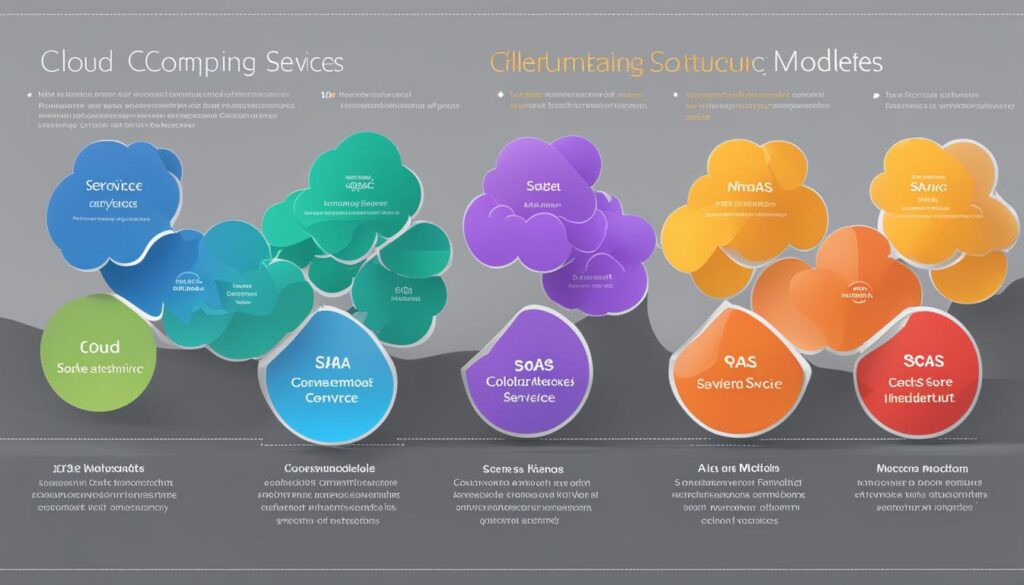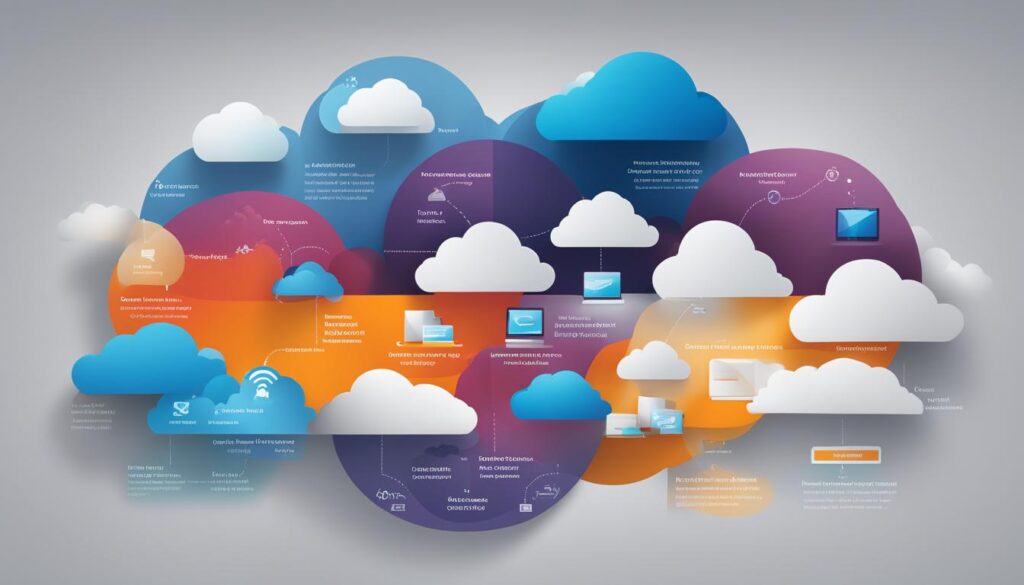Cloud deployment is a crucial aspect of information technology that has revolutionized the way businesses operate. With the advent of cloud computing, companies can harness the power of IT services and solutions to drive digital transformation and gain a competitive edge.
Cloud computing, in simple terms, refers to delivering hosted services over the internet. It offers three main types of cloud computing: infrastructure as a service (IaaS), platform as a service (PaaS), and software as a service (SaaS). By leveraging cloud technology, organizations can easily access scalable computing resources and IT services, transforming the way they manage their operations.
Cloud deployment can be implemented through private or public clouds, or a combination of both in the form of a hybrid cloud. It involves virtualization and automation technologies that enable efficient cloud infrastructure management and seamless cloud migration.
Contents
- 1 What is Cloud Computing and How Does it Work?
- 2 Different Types of Cloud Computing Services
- 3 Cloud Computing Deployment Models
- 4 Cloud Computing Spending and Growth Trends
- 5 Cloud Terminology and Definitions
- 6 Conclusion
- 7 FAQ
- 7.1 Is cloud deployment essential in information technology?
- 7.2 What is cloud computing and how does it work?
- 7.3 What are the different types of cloud computing services?
- 7.4 What are the different cloud computing deployment models?
- 7.5 What are the characteristics and advantages of cloud computing?
- 7.6 What are the trends in cloud computing spending and growth?
- 7.7 What are the key terms and definitions in cloud computing?
- 7.8 Why is cloud deployment essential in information technology?
- 8 Source Links
Key Takeaways:
- Cloud deployment is an essential component of information technology and plays a vital role in driving digital transformation.
- Cloud computing offers various types of services, including IaaS, PaaS, and SaaS, providing easy access to computing resources and IT solutions.
- Private and public clouds, as well as hybrid cloud environments, enable organizations to leverage cloud technology based on their specific requirements.
- Cloud deployment involves virtualization and automation technologies that enhance cloud infrastructure management and facilitate seamless cloud migration.
- By embracing cloud deployment, businesses can achieve scalability, cost-efficiency, and improved agility, leading to enhanced productivity and competitiveness.
What is Cloud Computing and How Does it Work?
Cloud computing is revolutionizing the way businesses access and utilize resources, enabling seamless connectivity and efficient operations. By leveraging cloud technologies, you can harness the power of hosted services over the internet, unlocking a world of possibilities for your organization.
The front-end of cloud computing comprises client devices and user interfaces, through which you interact with cloud software applications. These applications span a wide range of functionalities, from productivity tools to data analytics platforms, providing you with the flexibility to work remotely and collaborate seamlessly.
On the back-end, cloud computing relies on an intricate network of databases, servers, and computers that store and process data. These components are hosted in data centers, managed by cloud service providers, and are accessible via the internet. This infrastructure enables reliable and secure storage, ensuring that your information is protected and readily available when you need it most.
At the heart of cloud computing lies the concept of virtualization, which allows for the creation of virtual resources. Virtualization enables the efficient allocation and management of computing resources, such as processing power, memory, and storage, maximizing the utilization of available hardware. This technology optimizes resource allocation to meet the needs of various workloads, ensuring efficient and cost-effective operations.
Automation is another key aspect of cloud computing, streamlining processes and reducing the need for manual intervention. Through automation, tasks such as provisioning resources, configuring networks, and deploying applications can be streamlined, improving efficiency and reducing human error.
The diagram above visually represents the core components and mechanisms at play in cloud computing. The front-end and back-end components work together seamlessly to deliver hosted services over the internet, bringing you the benefits of flexibility, scalability, and cost-efficiency.
Different Types of Cloud Computing Services
When it comes to cloud computing, there are three main types of services that organizations can utilize: Infrastructure as a Service (IaaS), Platform as a Service (PaaS), and Software as a Service (SaaS). Each service offers unique benefits and caters to different business needs. Let’s take a closer look at each of these cloud computing services:
IaaS (Infrastructure as a Service)
IaaS providers offer virtual server instances and storage resources to organizations. This allows businesses to scale their IT infrastructure without investing in physical hardware. With IaaS, organizations have the flexibility to provision and manage virtual servers as per their requirements. Additionally, IaaS providers also offer APIs for seamless workload migration and integration with other systems.
PaaS (Platform as a Service)
PaaS providers offer a platform where developers can build, deploy, and manage applications over the internet. These providers host development tools, including programming languages, libraries, frameworks, and database management systems. By leveraging PaaS, organizations can streamline the application development process, reduce infrastructure overheads, and focus more on coding and innovation.
SaaS (Software as a Service)
SaaS delivers software applications over the internet as web services. These applications can be accessed from any location with internet access, eliminating the need for installation or local hosting. SaaS providers offer a wide range of applications, such as customer relationship management (CRM), enterprise resource planning (ERP), collaboration tools, and more. This allows organizations to use software applications without the need for upfront investments in licenses or infrastructure.
Cloud computing services can be categorized into three main types: IaaS, PaaS, and SaaS. Each type offers distinct advantages and caters to different use cases. Organizations can choose the service that aligns with their requirements to leverage the power of cloud computing and drive digital transformation.
In summary, cloud computing services provide businesses with the flexibility, scalability, and cost-effectiveness required to adapt to the rapidly evolving technological landscape. Whether it’s leveraging virtual servers and storage through IaaS, accessing development tools through PaaS, or utilizing software applications through SaaS, organizations can harness the power of cloud computing to enhance productivity, streamline processes, and achieve their business goals.
| Service | Key Features |
|---|---|
| IaaS |
|
| PaaS |
|
| SaaS |
|
By understanding the different types of cloud computing services, organizations can make informed decisions about which service best suits their needs. Whether it’s the flexibility of IaaS, the development capabilities of PaaS, or the convenience of SaaS, cloud computing services offer a wide range of solutions to drive business growth and innovation.

Cloud Computing Deployment Models
When it comes to cloud computing, organizations have various deployment models to choose from, each offering unique advantages and considerations. Let’s explore the different cloud computing deployment models:
1. Private Cloud
A private cloud is a cloud infrastructure that is solely dedicated to a single organization. It is hosted within the organization’s own data center or on-premises servers, providing greater control, security, and customization options. Private clouds are typically used by organizations with strict compliance requirements or sensitive data.
2. Public Cloud
A public cloud is a cloud service provided by third-party vendors over the internet. It offers shared resources and services to multiple organizations, allowing for cost efficiency and scalability. Public clouds are ideal for organizations looking for hassle-free management, as the infrastructure is fully maintained by the cloud service provider.
3. Hybrid Cloud
A hybrid cloud combines both private and public cloud environments to create a unified infrastructure. Organizations can leverage the security and control of a private cloud for mission-critical workloads, while also enjoying the scalability and cost-efficiency of the public cloud for non-sensitive workloads or workload bursts. Hybrid clouds enable seamless workload migration and provide the flexibility to adapt to changing business requirements.
4. Multi-Cloud
Multi-cloud refers to the use of multiple cloud service providers to host different parts of an organization’s infrastructure. It offers the benefits of diversification, enabling organizations to select the best services from multiple providers based on specific requirements such as pricing, performance, or geographic location. Multi-cloud strategies help mitigate reliance on a single vendor and promote innovation.
5. Community Cloud
A community cloud is a shared infrastructure that serves multiple organizations with shared concerns, such as regulatory compliance or security requirements. It allows organizations within a specific industry or community to collaborate and share resources while maintaining their distinct identities. Community clouds offer cost savings, improved security, and industry-specific customization.
Each cloud computing deployment model has its own strengths and considerations. Organizations can evaluate their needs and choose the model that best suits their requirements. The following table provides a summary of the different deployment models:
| Deployment Model | Description |
|---|---|
| Private Cloud | A dedicated cloud infrastructure hosted within the organization’s data center or on-premises servers. |
| Public Cloud | A cloud service provided by third-party vendors over the internet, offering shared resources and services. |
| Hybrid Cloud | A combination of private and public cloud environments, providing flexibility and scalability. |
| Multi-Cloud | The use of multiple cloud service providers, allowing organizations to leverage the best services from each. |
| Community Cloud | A shared infrastructure for organizations with shared concerns or industry-specific requirements. |
Choosing the right cloud computing deployment model is essential for organizations seeking to optimize their IT infrastructure. Assessing factors such as data sensitivity, compliance needs, scalability requirements, and budget considerations can help determine the most suitable deployment model for your organization. The image below illustrates the different cloud computing deployment models:

Cloud Computing Spending and Growth Trends
As businesses continue to undergo digital transformation, there has been a significant increase in cloud spending and a shift towards cloud infrastructure and services. This trend has been further accelerated by the global pandemic, which has highlighted the need for flexible and scalable IT solutions. Analysts predict that cloud infrastructure spending will continue to grow, reaching billions of dollars in the coming years.
One of the key drivers of cloud spending is the adoption of emerging technologies such as augmented reality (AR) and the metaverse. These technologies offer exciting opportunities for businesses to enhance their operations and improve customer experiences. To fully leverage the potential of AR and the metaverse, organizations are increasingly relying on cloud services and infrastructure deployment.
Cloud computing has proven to be a transformative technology for businesses across various industries. Many organizations have already embraced cloud computing and have successfully deployed cloud solutions to optimize their operations and drive innovation. These successful cloud-computing case studies serve as inspiration for other businesses looking to adopt cloud technologies.
Overall, the growth of cloud spending reflects the increasing recognition of the value and benefits that cloud infrastructure and services bring to businesses. The cloud offers scalability, cost efficiency, and the ability to adapt to changing market demands. As organizations continue to prioritize digital transformation, cloud computing will play a central role in shaping the future of IT infrastructure.
| Cloud Spending Drivers | Cloud Spending Benefits |
|---|---|
|
|
Case Study: Company X
“Our transition to cloud computing has been a game-changer for our business. We have been able to scale our operations seamlessly, reduce costs, and better serve our customers. The cloud has empowered us to innovate and stay ahead of the competition.”
Case Study: Company Y
“By leveraging cloud services, we were able to quickly adapt to the challenges posed by the pandemic. Our employees were able to collaborate remotely, and we achieved significant cost savings by migrating our workloads to the cloud. Cloud computing has been instrumental in our success during these uncertain times.”
In conclusion, the continuous growth in cloud spending reflects the increasing importance of cloud infrastructure and services in the digital era. Businesses are recognizing the value of cloud computing in driving innovation, optimizing operations, and staying competitive. As technologies like augmented reality and the metaverse continue to evolve, the demand for cloud services and infrastructure deployment will only intensify.
Cloud Terminology and Definitions
Understanding cloud terminology is essential for navigating the complexities of cloud computing. Here are some key definitions to help you grasp the concepts:
- Cloud Security: Refers to measures implemented to safeguard data and protect against unauthorized access, data leaks, and compliance violations. Security protocols, encryption, user authentication, and access controls are critical components of cloud security.
- Cloud Management: Involves overseeing and optimizing cloud environments, including provisioning resources, monitoring performance, managing costs, and ensuring overall operational efficiency.
- Cloud Infrastructure: Comprises the physical and virtual components necessary for cloud computing, such as servers, storage, networking, and virtualization technologies. It provides the foundation for running applications and storing data in the cloud.
- Cloud Automation: Encompasses the use of software and tools to automate tasks and processes in the cloud, reducing manual intervention, improving efficiency, and enabling rapid scalability. Automation helps streamline resource provisioning, configuration management, and workload deployment.
- SaaS (Software-as-a-Service): SaaS is a cloud service delivery model where applications are hosted and provided over the internet. Users can access software applications on-demand, eliminating the need for local installation or management.
- PaaS (Platform-as-a-Service): PaaS offers a cloud-based platform that provides developers with tools, frameworks, and infrastructure to build, deploy, and manage applications. It simplifies the development lifecycle by abstracting the underlying infrastructure.
- IaaS (Infrastructure-as-a-Service): IaaS offers virtualized computing resources such as servers, storage, and networks over the internet. It provides businesses with the flexibility to provision and manage their own virtual infrastructure while outsourcing the physical infrastructure maintenance.
- Cloud Application: A software application designed to run on cloud infrastructure, taking advantage of cloud scalability, availability, and accessibility.
- Public Cloud: A cloud computing model where cloud services are offered by third-party providers over the internet, accessible to the general public. Resources are shared among multiple users, providing scalability and cost efficiency.
- Private Cloud: A cloud infrastructure exclusively dedicated to a single organization, either on-premises or hosted by a third-party provider. It offers enhanced security, control, and customization options.
- Hybrid Cloud: A cloud environment that combines public and private clouds, allowing organizations to leverage the advantages of both. It enables workload flexibility, scalability, and the ability to address specific security or compliance requirements.
- Multi-Cloud: The use of multiple cloud service providers to distribute workloads across different cloud environments. It provides organizations with vendor diversification, redundancy, and the ability to optimize costs.
Having a clear understanding of these cloud-related terms will empower you to make informed decisions when it comes to cloud adoption, security, management, and infrastructure choices.
Cloud Terminology Examples:
“To ensure the integrity and confidentiality of sensitive data, robust cloud security measures should be implemented, including encryption, multi-factor authentication, and rigorous access controls.”
“Efficient cloud management practices involve automating resource provisioning, optimizing costs, and monitoring performance to ensure optimal application availability and user experience.”
Cloud Service Delivery Models:
| Service Delivery Model | Description |
|---|---|
| SaaS (Software-as-a-Service) | Cloud-based software applications accessible over the internet without the need for local installation or management. |
| PaaS (Platform-as-a-Service) | Cloud platform offering developers tools, frameworks, and infrastructure to build, deploy, and manage applications. |
| IaaS (Infrastructure-as-a-Service) | Virtualized computing resources provided over the internet, including servers, storage, and networks. |

Conclusion
Cloud deployment is an essential aspect of information technology, driving digital transformation and revolutionizing the way businesses operate. With its scalability, cost management, and workload mobility benefits, cloud computing has become the go-to solution for organizations worldwide. Whether leveraging private, public, hybrid, or multi-cloud environments, businesses can tap into the power of cloud solutions to enhance their efficiency and agility.
As technology continues to advance, cloud deployment remains a fundamental component of modern IT infrastructures. The flexibility and scalability of the cloud enable businesses to adapt quickly to changing market demands, optimize resource allocation, and drive innovation. Through cloud computing, organizations can embrace digital transformation, streamline processes, and stay ahead of the competition.
Embracing a hybrid cloud approach allows businesses to combine the best of both worlds by leveraging the benefits of private and public clouds. This strategic deployment model offers increased flexibility, improved security, and cost-effectiveness. With hybrid cloud solutions, organizations can dynamically scale their infrastructure, seamlessly integrate on-premises and cloud-based applications, and ensure business continuity.
In conclusion, cloud deployment is a game-changer in the realm of information technology. By harnessing the power of cloud computing, businesses can unlock new opportunities for growth, innovation, and operational efficiency. As the digital landscape continues to evolve, the cloud will play an increasingly vital role in shaping the future of organizations across industries.
FAQ
Is cloud deployment essential in information technology?
Yes, cloud deployment plays a crucial role in information technology. It allows businesses to leverage cloud computing services, such as infrastructure as a service (IaaS), platform as a service (PaaS), and software as a service (SaaS), to enhance their efficiency and agility.
What is cloud computing and how does it work?
Cloud computing is a method of delivering hosted services over the internet. It involves three main types: IaaS, which provides virtualized server instances and storage; PaaS, which offers development tools hosted on cloud infrastructures; and SaaS, which delivers software applications as web services accessible over the internet.
What are the different types of cloud computing services?
Cloud computing services can be categorized into three main types. IaaS providers offer virtual server instances, storage, and APIs for workload migration. PaaS providers host development tools on their infrastructures, allowing users to access them over the internet. SaaS delivers software applications over the internet as web services, accessible from any location with internet access.
What are the different cloud computing deployment models?
Cloud computing deployment models include private cloud, public cloud, hybrid cloud, multi-cloud, and community cloud. Private cloud services are delivered from a business’s data center to internal users, while public clouds are provided by third-party service providers over the internet. Hybrid clouds combine public and private clouds, multi-cloud involves using multiple cloud providers, and community clouds are shared by multiple organizations with shared concerns.
What are the characteristics and advantages of cloud computing?
Cloud computing offers self-service provisioning, elasticity for scaling up or down as needed, pay-per-use pricing, workload resilience, migration flexibility, broad network access, multi-tenancy, and resource pooling. These characteristics provide benefits such as scalability, cost management, workload mobility, and improved efficiency for businesses.
What are the trends in cloud computing spending and growth?
Cloud spending continues to rise as businesses accelerate their digital transformation plans. Analysts predict continuous growth in cloud infrastructure spending, reaching billions of dollars. The adoption of augmented reality and the metaverse presents a new growth opportunity for cloud services and infrastructure deployment. Numerous case studies demonstrate successful cloud deployments across various industries.
What are the key terms and definitions in cloud computing?
Cloud terminology includes definitions of various cloud-related concepts. Cloud security refers to measures to prevent data leaks and ensure compliance with regulations. Cloud management involves overseeing and optimizing cloud environments. Cloud infrastructure consists of the necessary components for cloud computing. Cloud automation involves performing tasks with minimal human intervention. SaaS, PaaS, and IaaS are different service delivery models in cloud computing. Cloud applications can be hosted on public, private, hybrid, or multi-cloud environments.
Why is cloud deployment essential in information technology?
Cloud deployment is fundamental in information technology as it drives digital transformation and offers various benefits such as scalability, cost management, and workload mobility. By leveraging cloud solutions, businesses can enhance their efficiency and agility, adapt to changing market demands, and stay competitive in today’s rapidly evolving digital landscape.




